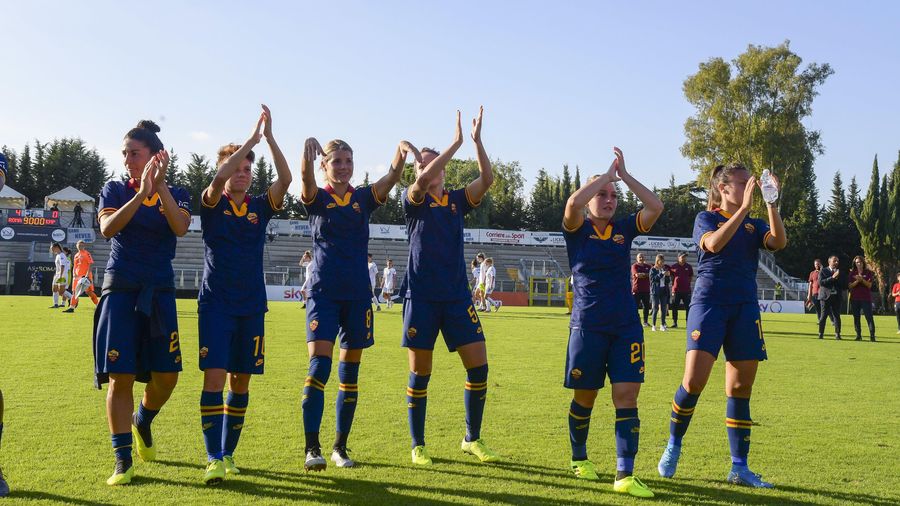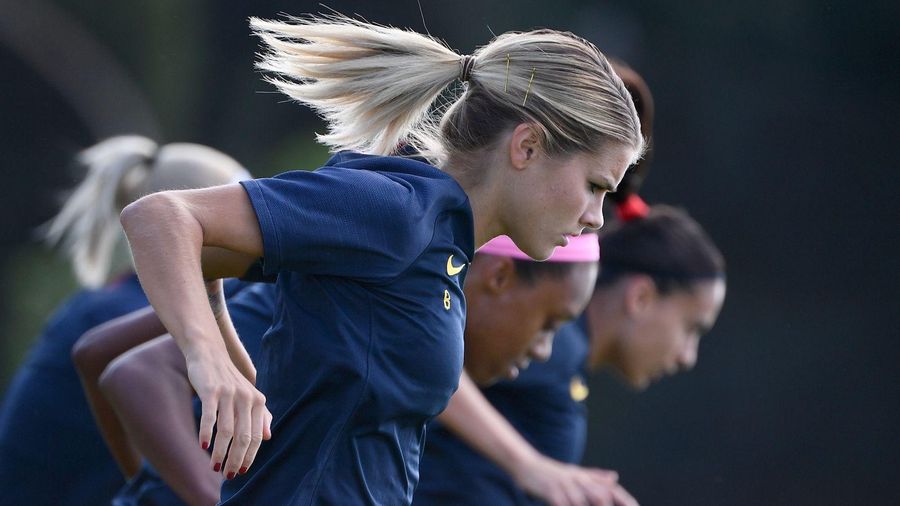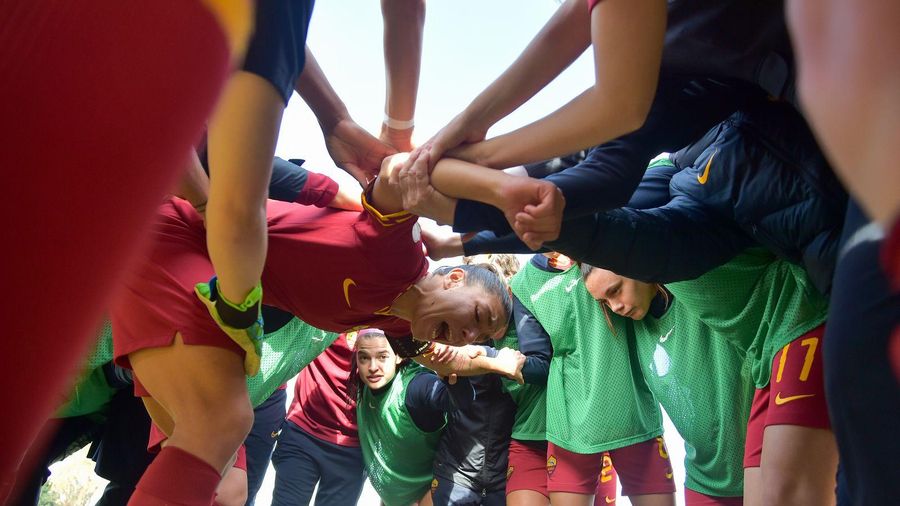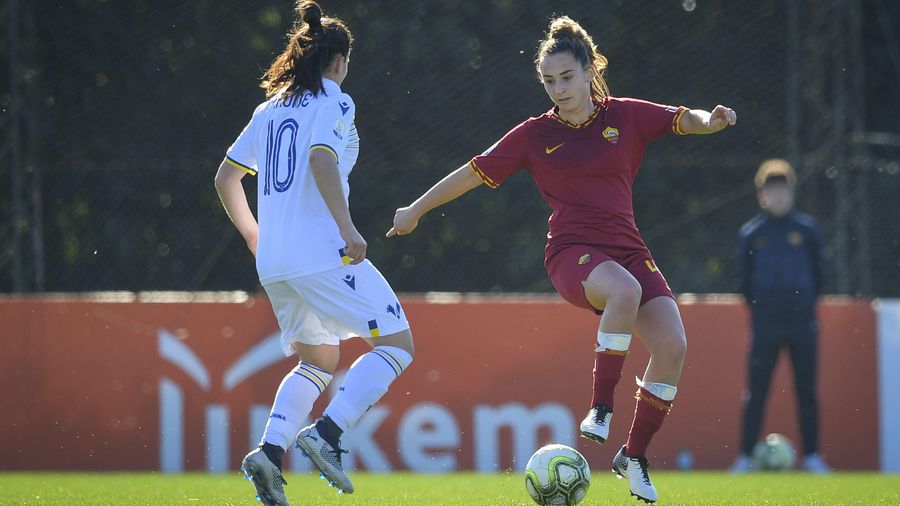

Roma Women are beginning their return to training ahead of their third season in Serie A Femminile – looking to continue the upwards trajectory they have been following since their formation.
After finishing fourth in their debut season, Roma were in the same position - albeit only two points short of matching their first season points tally - when their second was curtailed with six games to spare.
Had things been allowed to continue, Roma would surely have surpassed the achievements of their first year – while they also still had something to play for in the Coppa Italia, which they had reached the semi-finals of for the second season running.
As the squad prepare to try and improve even further for the upcoming 2020-21 campaign, here’s a look back at the factors that helped them develop in their second season – a trend they will be hoping to continue.
Increased tactical flexibility
In Roma’s first season together, coach Betty Bavagnoli mainly stuck to using a 4-3-3 system. It was relatively effective at the time, but every team needs another plan to resort to.
Bavagnoli is an experienced coach who will have been fully aware of this. However, she needed a player to unlock the potential of a more fluid formation. That player was Andressa Alves.
When Roma signed Andressa last summer, they knew they were getting a player of the highest quality. You don’t become a regular for Brazil and Barcelona without being exactly that.
The experience Andressa brought manifested itself best in her versatility. Beginning her time with the club as a right winger, as her form and fitness improved she eventually transitioned into a central midfield role, with regular licence to get forward.
That shift enabled Bavagnoli to tweak her system, from a 4-3-3 to a 4-2-3-1, depending on the circumstances – the change sometimes even occurring during games.
Andressa was given freedom to find pockets of space from which to influence proceedings – and her intelligence ensured she did just that.
Overall, that gave Roma greater flexibility. Bringing a key player closer to the centre of the action, but not restricting her, made Roma a more effective attacking outfit.
Bavagnoli now had two genuine options to work with tactically, enabling the team to have a solid structure defensively, but also freedom going forward.
Thomas gives Roma a focal point
Ever the perfectionist, another adaptation Bavagnoli will have wanted to see was a better connection between the central striker and the rest of the team.
In 2018-19, despite their best efforts, Martina Piemonte and Luisa Pugnali did not quite reach the heights they would have liked. That left a goalscoring burden on Annamaria Serturini from out wide.
Roma needed to find a way to get goals from a central area. Cue the arrival of Lindsey Thomas, and cue the solution to those problems.
Thomas arrived on the back of just a four-goal season in France, but, taking no time at all to adapt to Italian football, she matched that tally at Roma even before Christmas.
Starting more league games than any other player, the versatile forward was a dynamic presence up front. Thomas dominated her territory, giving her teammates something to build from.
At the time of the league’s suspension, Thomas was the highest-scoring non-Italian player of any team. And her nine goals showed a range of techniques.
There were tap-ins after intelligent movements, darting runs to the near post before cut-back finishes, and most memorably of all, a goal from outside the box against Milan and a deft chip against Orobica.
Thomas was a livewire, always ready to pounce and find a goalscoring opportunity. She proved to be the missing piece to the puzzle that Roma needed to become more dangerous in attack.
Thanks in part to the extra dimension Thomas provided – but also due to Agnese Bonfantini becoming more clinical, the extra threat from midfield via Andrine Hegerberg (who scored five goals between league and cup) and the workrate and goals chipped in by Amalie Thestrup – the Giallorosse were the second highest scoring team in Serie A in 2019-20, behind only champions Juventus.
In fact, by reaching 41 goals with six games still left to play, Roma were just two away from matching their tally from the entirety of the season before.
Roma develop international appeal
In their first season in women’s football, the club had relied on a core of promising Italian – and largely Roman – talent.
The hometown duo of Elisa Bartoli and Giada Greggi were given starring roles, while as mentioned, Bergamo-born Serturini took on much of the goalscoring responsibilities.
For their first summer re-shuffle of the squad, Roma broadened their horizons, while still maintaining that local core.
With the players they brought in, Roma showed they could attract major international stars. The club managed to lure players like the Brazilian Andressa, the French Thomas, Danish forward Thestrup and the Norwegian Hegerberg to Italy.
Other foreign players who already had experience in Serie A were picked out from other teams, including the Romanian Camelia Ceasar and the Slovenian Kaja Erzen. Like Andressa, Thomas and Hegerberg, they both became regulars.
Choosing a new club is not an easy decision for a player, especially if it involves moving to a different country. But for a club who are still in the relatively early days of their foray into women’s football, Roma showed that they could compete for major signings of international level.
In total, players of six different foreign nationalities scored for Roma in 2019-20 – an increase from the four of the season before.
Hence, not only did Roma have the top foreign scorer in the league, they also had (with Juventus) the joint-highest number of foreign scorers.
Roma also managed to acquire the services of highly-rated Italian players, such as Manuela Giugliano.
There was a lot of competition for the midfielder, who had excelled at last year’s World Cup, but she chose Rome – and quickly found her home.
Giugliano brought quality, vision and rhythm to the midfield. Her ability on the ball gave Roma a new dimension.
Retaining her services – it will be the first time the 22-year-old has spent a second season with a club – will be just as beneficial as any new arrival. The fact that she is settled in the capital suggests positive things are happening at Stadio Tre Fontane.
It proves that players are believing Roma is a good place to be, and means more may be encouraged to sign up as the squad continues its evolution.
Indeed, Roma have already brought in Spanish forward Paloma Lazaro from Fiorentina, whose experience and eye for goal could make her a welcome addition.
Stronger starts lead to success
Whereas in their first season the majority of Roma’s goals came in the last half-hours of games, second time around they tended to come out of the traps more quickly.
In total, taking into account league games only, Roma scored 10 goals inside the opening 15 minutes of matches. That was already more than the eight they managed the year before.
In fact, in their second season, Roma scored seven more goals in the first half than they did in season one. If they had continued at a similar rate had the season reached a natural conclusion, they would have doubled their output in that category.
On four occasions – Vanessa Bernauer against Empoli, Elisa Bartoli against Verona and Agnese Bonfantini against both Bari and Sassuolo – Roma even managed to score within the first five minutes.
It shows that Bavagnoli’s message was being put into action straight away. Often, when Roma took the lead, they didn’t look back.
Impressively, in all the games in which Roma scored first, they only dropped points once – in the frustrating 3-2 loss to AC Milan in January.
Clearly, then, the positive manner in which Roma started games benefitted their results overall.
But, given that Roma tended to do well when starting strongly in their first season as well, the biggest way in which their first half performances developed was defensively.
In total, Roma conceded just four goals in the first halves of their league matches. That was less than half of how many they let in during the opening 45 minutes of games in their debut campaign.
If Roma can replicate those concentration levels in the later stages of games, to prevent outcomes like that in the Milan defeat, then it will give them a chance of doing even better next year.
Promising core develops at the back
For all Roma improved in terms of goalscoring in their second season, they also showed signs of becoming a stronger defensive unit.
The departure of Emma Lipman, their oldest centre-back at the end of their first season, may have led to concerns that there would not be enough experience in the defence.
However, summer signing Tecla Pettenuzzo stepped up and showed maturity beyond her 20 years.
After arriving from Sassuolo, Pettenuzzo started 11 of Roma’s 16 league games, appearing as a substitute in two others. She soon proved herself to be indispensable.
The Italian became part of a promising core at the back – with Allyson Swaby another important element.
Having joined Roma partway through their first season, this was supposed to be Swaby’s first full campaign in Serie A, before it was curtailed. And starting 13 times, the 23-year-old showed that she is getting more comfortable in Italian football with every game.
Pettenuzzo and Swaby will have surely learned a lot from the more senior Federica Di Criscio, who was performing at a consistent level until her injury. But after that unfortunate moment, the duo showed they had enough understanding to perform well without her.
Indeed, Roma conceded just two goals in their last five games in all competitions, before footballing activity was stopped.
Now that Di Criscio has departed, another option may need to be sourced as a point of reference for the group, but Roma can still be confident that they have capable players at the back.
And behind them was another player who had taken a key role despite her relative inexperience. Goalkeeper Camelia Ceasar, 21 at the time of her arrival, inherited the starting berth from 34-year-old Rosalia Pipitone, who had been a safe pair of hands in Roma’s first season.
Ceaser quickly stepped up to the mark, keeping clean sheets in her first three games – including in the impressive 2-0 win over title challengers Fiorentina (during which she also saved a penalty) towards the start of the season.
Overall, she conceded just 14 goals from 13 appearances – ending the season with six clean sheets in Serie A.
In Pettenuzzo, Swaby and Ceasar, Roma have found players who can become solid components in a key area of the pitch. Those players will need to acquire further experience, and will surely face challenges from others within the squad, but the future looks bright.
Follow Samuel Bannister on Twitter here.

 Tickets
Tickets
 Shop
Shop








































